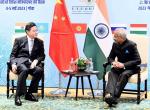Introduction
The Vietnamese economy at the time of unification on 30 April 1975 was a highly centralised planned economy like the former Soviet Union. This underwent change with the introduction of Doi Moi in 1986. With the breakup of the Soviet Union in 1991, the economy transformed into a socialist market economy similar to Russia and China. Currently, Vietnam is a part of the global economy. Vietnam today exports agricultural and industrial products. In 1997, Asia faced a financial crisis which made Vietnam cautious in undertaking accelerated economic reforms. The turnaround came with the signing of the Bilateral Agreement with the United States (US) on 13 July 2000. This enabled Vietnam to trade with the US and Europe as also brought in Foreign Direct Investment from numerous countries, resulting in a high rate of growth and economic development.
In 2001, the Vietnamese Government approved a 10 year economic plan that enhanced the role of private sector, while reaffirming the primacy of the state. The rate of growth grew from 6% to 7% between 2000 to 2002. It is pertinent to note that the growth rate continued to increase and soon it was just next to China in this field reaching a high over 8%, thereby becoming the world’s second fastest growing economy. Simultaneously, investment grew three fold and domestic savings quintupled. On 11 January 2007, Vietnam became the 150th member of World Trade Organisation (WTO). The membership of WTO resulted in stiff competition which compelled the Government to deal sternly with non performing State Owned Enterprises resulting in privatisation of 30 to 50% of these enterprises thereby stabilising the situation reasonably. Vietnam with its high growth rate is moving on an upward trajectory.
Current Status
Vietnam is currently a part of the globalisation process and is a member of WTO, ASEAN Free Trade Area (AFTA), Asia Pacific Economic Cooperation (APEC), Association of South East Asian Nations (ASEAN) and Food and Agriculture Organisation (FAO). The nominal GDP is $ 187.848 billion and converted to Purchasing Power Parity (PPP) works out to $ 509.466 billion. In the current year, the GDP witnessed a growth of 5.62%. The per capita income is $ 2073 as per nominal calculations and $ 5621 as per PPP. The GDP as applicable to sectors is as follows: Agriculture - 19.3%, Industry – 38.5 % and Services – 42.2%. The population by occupation is Agriculture – 48%, Industry -21 % and Services- 31%. The population below the poverty line is 10% and unemployment is about 2%.The main agricultural as also meat products are rice, coffee, rubber, cotton, tea, pepper, soya beans, cashew nuts, sugar cane, peanuts, bananas, poultry, fish and sea food. The main exports are clothes, shoes, marine products, crude oil, electronics, wooden products, rice and machinery. The total exports are about $ 128.9 billion. The imports are machinery and equipment, petroleum products, steel products, raw materials for clothing & shoe industries, electronics, plastics and automobiles. The total imports account for $ 121.4 billion. US is the highest export partner accounting for about 17.8% of the exports and China is the highest import partner accounting for 25.8% of the imports. The public finances are rated as stable and the Government has been taking corrective measures to keep the economy on course.
Economic targets for 2015
The eighth session of the 13th Vietnamese National Assembly commenced in Hanoi on 20 October 2014. The Prime Minister Mr Nguyen Tan Dung in his speech stated that despite a promising outlook for 2015, inefficiency, bad debt and domestic sentiment will moderate the growth rate. The Prime Minister set out a growth rate of 6.2% for 2015. He also emphasised that inflation will be maintained at 5% resulting in reduction of poverty by another 1.7 % and creation of additional 1.6 million new job opportunities. The rise recorded in recent months is driven by strong exports and a booming manufacturing sector.
Experts feel that to reach a growth rate of 6.2% there would be a need to boost investment to the tune of 33 to 35% of GDP. Further, Vietnam is pushing ahead with its plan of disinvesting its 1000 State Owned Enterprises. The Ministry of Planning and Investment was asked by the Government to withdraw its proposal for using the state budget to settle bad debt of State Owned Enterprises. It is estimated that the bad debt works out to $ 80 billion. Further, the Government wants to tackle corruption which exists in finance, banking, land management, natural resources exploitation and public investment. Despite these irritants, Vietnamese economy has stabilised. The forecasts predict that in the short run, Vietnamese economy will grow at a slightly slower speed and will accelerate to high growths in the long run once the shortcomings are addressed.
Current Economic Cooperation with India
India and Vietnam have been cooperating extensively in the economic field. India has offered Vietnam 18 Lines of Credit as on date. The Vietnamese Prime Minister recently visited our country on 27 and 28 October 2014.In the Joint statement issued by both the Prime Ministers, it was agreed that economic cooperation between both countries should be pursued as a strategic objective. They welcomed the strong growth in bilateral trade in recent years particularly after the India- ASEAN trade in Goods Agreement.
They also noted that the conclusion of India-ASEAN trade in Services and Investment agreement would further boost economic cooperation between India and ASEAN in general as also Vietnam in particular. They also called for closer Regional Economic Partnership Agreement (RECP).
Business leaders of both countries identified priority areas for cooperation. These included hydrocarbons, power generation, infrastructure, tourism, textiles, footwear, medical and pharmaceuticals, Information & Communications Technology (ICT), electronics, agriculture, agro-products, chemicals, machine tools and other supporting industries. They agreed to enhance bilateral trade to $ 15 billion by 2020.
The Prime Ministers reaffirmed the importance of investment for the growth of their economies. Prime Minister Dung welcomed Indian companies to invest in Vietnam and Prime Minister Modi invited the Vietnamese companies to join the accelerated economic growth programme ‘Make in India’ for establishing their industries in India. It was agreed that the Customs Cooperation Agreement and Maritime Shipping Agreement between the two countries be optimised to facilitate greater economic engagement.
Both the Prime Ministers welcomed the signing of Agreement between ONGC Videsh and Petro Vietnam for exploration of new oil and gas projects in Vietnam. Prime Minister Dung welcomed Indian Oil and Gas companies to explore new opportunities in midstream and downstream activities in the oil and gas sector in Vietnam.
It was a great step that the Vietnam Bank had agreed to the proposal to open a Bank of India branch in Vietnam. Further, to improve connectivity, Jet Airways is going to commence direct flights to Ho Chi Minh City from India with effect from November 2014.
Another area which will provide an impetus to our economic relationship would be the construction of a Thermal Power plant. Tata Power plans to develop US $ 1.8 billion Long Phu Thermal Power Plant in Soc Trang which is located in the southern portion of the country. An MOU has been signed in this connection in November 2013. Efforts are being made to expedite the commencement of construction of the project. All these issues will assist Vietnam in stabilising its economy and build its Comprehensive National Power.
Conclusion
The Vietnamese economy continues to grow at about 6% despite its problems with State Owned Enterprises. India and Vietnam have strengthened their economic cooperation over the last four decades that has been mutually beneficial which has, in turn, led to strengthening of their strategic relationship. Growing economies of both the countries offer several opportunities for India to enhance its investment and trade with Vietnam. There is an expanded scope for Indian companies to invest in Vietnam in a variety of sectors besides oil and the mineral sector. Investment and trade potential between both the nations is very large and has not been fully exploited. With Prime Minister Modi at the helm of affairs in India, it is time to impart momentum to India’s economic engagement with Vietnam.
(The author was India’s Defence Attache to Vietnam)
Published date: 27th November 2014, Image source: http://vietlaw4u.com
(Disclaimer: The views and opinions expressed in this article are those of the author and do not necessarily reflect the official policy or position of the Vivekananda International Foundation)










Post new comment